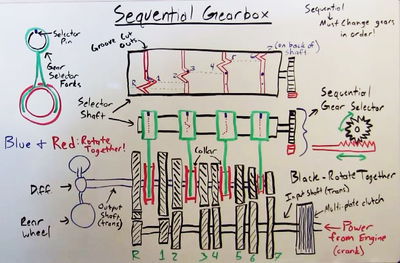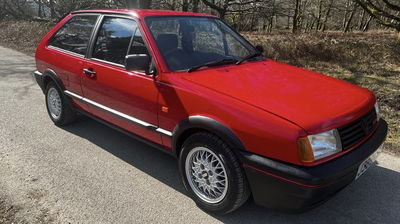Engineering Explained: How Sequential Transmissions Work

There’s a bit of terminology to become familiar with (see drawing below) before understanding how this transmission works. Note that many of these terms may have alternative names; I’ve simply chosen terms that I believe are simple to understand.
Sequential Transmission
A type of transmission that allows for manual gear selection, though the gears must be selected in order, as it will not allow for skipping gears like a traditional manual. The method of switching gears is unique to this transmission type, where a selector shaft is used to upshift or downshift.
Gear Selector Fork
This is the selector used to engage the dog clutch rotating with the output shaft to the gear rotating with the (power) input shaft. (This pushes the transmission into various gears).
Selector Pin
This is located on the selector fork and is used to guide the selector through the grooves on the selector shaft.
Selector Shaft
This shaft is what all of the selector forks connect to, and it has grooves cut into it which is the path that the selector pin will follow.
Sequential Gear Selector
This is used to rotate the selector shaft, and is what the driver will be altering when they select a gear. Note that there are many ways to mechanically rotate a shaft aside from the image below (could be pneumatic, hydraulic, electronic, etc.).
Multi-Plate Clutch
The multi-plate clutch is used to connect/disconnect engine torque from the transmission input shaft. As the name implies, there are multiple clutch discs within.
Dog Clutch
A form of clutch engagement that uses interference rather than friction discs (like a traditional clutch) to rotate two shafts at a common speed. Shifting with dog clutches only requires a short moment without torque being transmitted, thus it is often the case that using a clutch is not necessary (simply ease off the throttle).

Now that we have the terminology down, let’s take a look through the sequence of events of how this transmission selects gears:
1. Starting with the car in neutral, and thus none of the dog clutches engaged, the driver will select first gear. By doing so the gear selector will rotate the selector shaft.
2. As the selector shaft rotates, the selector pins move with the grooves on the selector shaft, thus moving the selector forks.
3. The selector fork responsible for first gear will move to engage the dog clutch, which is splined to the transmission output shaft, to first gear, which is connected to the transmission input shaft.
4. Once the dog clutch for first gear is engaged, torque is transmitted through this set of gears to the output shaft which powers the driven wheels.
5. When the driver selects second gear, the selector shaft rotates again. This time, the selector fork for first gear disengages the dog clutch, while the selector fork for second gear engages the dog clutch. This process continues as the driver selects various gears.
6. Once the transmission is in a selected gear, the design of the selector shaft requires that gears must be selected sequentially (1-2-3-4, etc.) and cannot be skipped. This is quite different from a manual transmission, where for example it is possible to go from 2nd gear to 5th, or downshift from 6th gear to 3rd, without selecting the gears between.
Here’s a video explaining how they work:














Comments
No comments found.